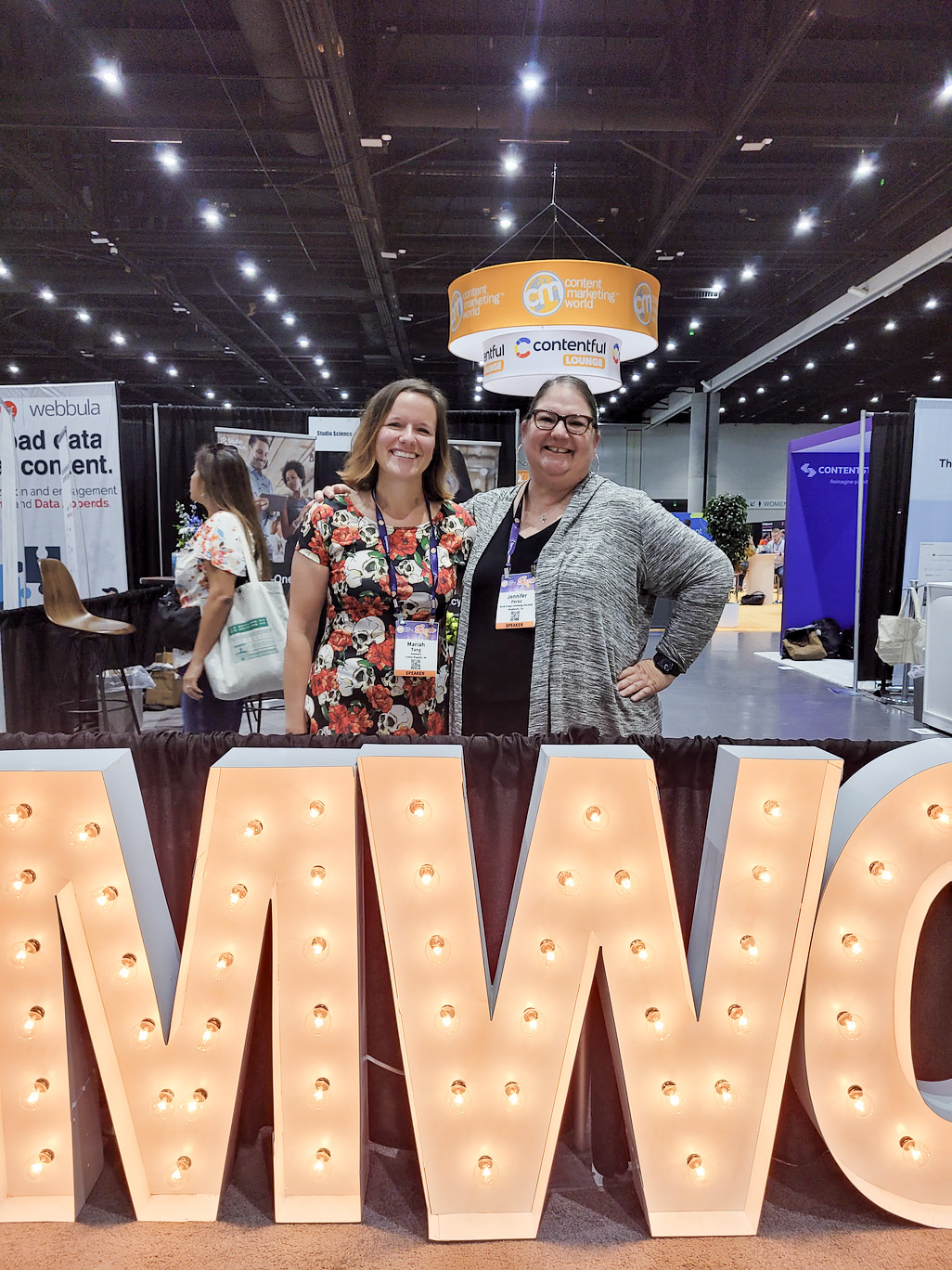
Mariah Obiedzinski Tang
October 25, 2024

I rolled into my seventh speaking experience at Content Marketing World expecting to hear a lot … like A LOT … about the explosion of AI content creation tools and why I should have gone into a safer career, like paleontology as my dad suggested.
Last year, the “Robots will never take our jobs!” vibe drove strong emotions from speakers and attendees. This year, though AI surfaced in nearly every session, I was pleasantly surprised by the challenging, yet optimistic, perspective I gained from each session.
It felt like the dust has settled on the AI Freakout of 2023, and industry experts are feeling more enlightened than afraid of the possibilities of AI in marketing. Session discussions were wiser, focusing on how AI tools can help creators reconnect with and leverage our humanity in the creative process—not how to avoid the creative struggle that produces the best work.
Rather than turning creative work over to AI, marketers should use it to give creative teams more room for innovation and creativity. In doing so, brands can find their way back to the heart of marketing—understanding the pain points and human needs of their audience—and create content that leads with emotion to achieve customer satisfaction and realize our business goals.
Three main themes surfaced among the keynotes, my session with Jennifer Perez of North Orange Continuing Education, and the sessions I was fortunate to attend.
Robert Rose, internationally recognized content expert and founder/chief strategy officer of The Content Advisory, kicked off the conference keynotes by introducing the elephant in the room: Marketers today are treading water.
Trying to do *all the things* with strapped resources hinders creativity. The creative struggle, which Rose calls “valuable friction,” is the work that makes us wiser as marketers and strategists. Friction sparks fire, and first leads to innovation.
So don’t be tempted to turn friction work over to AI, cautions Rose. Passionate content marketers create authentic, unexpected, and enlightened thought leadership pieces that drive meaningful, SEO-rich engagements. Stories appeal to consumers in a way that generic AI content simply can’t (yet).
Instead, Rose challenged brands to leverage the efficiencies of AI to turn the building blocks of your creative process into strategic steps—making space for your strategists to take those ideas to the next level. Companies that lean into the power of tech-supported human creativity and innovation will become the content authorities in the age of AI.
Ann Handley, Chief Content Officer of MarketingProfs, echoed Rose’s sentiment that with great speed comes great responsibility—to use generative AI appropriately and authentically in content creation.
GenAI invites us to ask important questions that can help marketers create content more efficiently. But, Handley asks, is speed always the goal?
In the creative process, fast does not always (often?) equal good. And “good” is not good enough for brands that want to make an impact. So, Handley said, we must be strategic in the shortcuts we take. Otherwise, we risk losing the storytelling spark that makes our brand content unique, along with the experience that makes our audience feel seen.
R. Ethan Braden, Vice President, Chief Marketing and Communications Officer, Texas A&M University, gave a moving keynote that hit this message on the head. After making everyone tear up over Google’s 2013 “Reunion” ad—a sentimental reunion between two grandfathers who were childhood friends, powered by Google Search—Braden reminded the audience that brands aren’t selling a thing or a service. Rather, brands provide an experience that resolves a need or fulfills a wish.
Braden showed a photo of a drill bit and explained that consumers typically don’t buy something just to own it. There’s a need to fill, and emotions connected to that need. The satisfaction isn’t in owning the item, it’s the feeling one gets from its use.
Paraphrasing Seth Godin, Braden said consumers buy drill bits to make holes, but the holes aren’t the outcome your product/service fulfills. The consumer buys a drill bit to hang those family photos that have collected dust on the floor for a year. That satisfaction is the moment the drill bit company should appeal to in their marketing—and today’s AI tools can’t capture those sentiments as well as a human can.
Erika Heald, founder of Erika Heald Marketing Consulting, provided guidance for setting up your brand strategy to put this sentiment in motion with the use of AI tools. Since how consumers talk about (and search for) answers to their needs changes rapidly, it can be challenging to make sure your brand voice echoes their desired outcome.
Heald suggests using AI to create a list of Dos and Don’ts for brand content creation. You can train the tool with examples of “good” and “bad” branded content, then ask it to create a table or document that outlines the sentiment with which your brand aims to align.
Heald did not suggest using AI to fully create important branded content for you—the current AI tools are designed to support the creative process, not take it over entirely. When we turn over creative work to AI, she cautions, it will be obvious that your brand’s humanity has been glossed over with generic phrasing.
Jennifer Perez, Director, Campus Communications, North Orange Continuing Education (NOCE), highlighted the importance of empathizing with your audience beyond the marketing personas AI can help create.
NOCE provides free career upskilling services, ranging from citizenship and English as a Second Language courses to IT and Bookkeeping training for underserved adult learners in Orange County, California. But for many students, the desire for job training floats in a sea of unmet needs: Substandard housing, food insecurity, and limited flexibility due to lacking childcare or work schedules. Missed the session? Email me to get the slides.
NOCE provides supportive services to help underserved adult learners meet these needs, reducing the mental load so students can get the education they need to thrive. Perez noted in her presentation with Stamats that only by inviting members of their audience to be vulnerable in personal conversations—in-person, over Zoom, and by survey—can NOCE help students achieve their educational and professional goals.
Analisa Goodin, CEO of Catch+Release, showcased the power of understanding your audience by leveraging user-generated (UG) content. She played a heart-tugging Mother’s Day video ad from Teleflora’s “The Hardest Part” campaign that captured the trials and joy of motherhood. The piece was created almost entirely with licensed UG content found through the AI-driven search function of the Catch+Release platform.
Goodin noted that leveraging UG content mutually benefits creators, audiences, and brands. Creators love the content engagement. Audiences value seeing real people feel authentic emotions. And brands can appeal to the emotional impact that drives consumers to action.
Artificial intelligence tools are changing how creatives tell your brand story. But if your team or vendor believes that churning out high-speed, low-authenticity content for your brand is good enough, it’s time to reconsider your strategy.
As these CMWorld experts remind us, marketing success is built on human innovation and creativity. While AI can improve efficiency, strategic use is imperative. Brands that find content success in the age of AI will be those that respect the balance of humanity and mechanics, continually optimizing the use of AI to support and challenge creators in content delivery.
Ready to revamp your content strategy? Email me today.